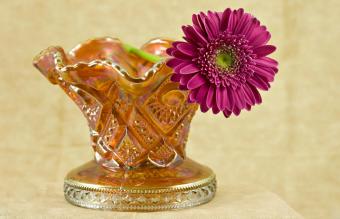
Keep the vibrant colors and beautiful iridescent surface of your glass collection intact by learning to how to clean antique carnival glass the right way. This collectible type of glassware, which people used to win at carnivals and buy in stores, has a very fragile surface. Cleaning it the wrong way can destroy its beauty.
Identifying Carnival Glass
Before you begin cleaning a glass item, it's a good idea to identify whether it is real carnival glass. You can also look for antique glass markings to help identify it. This popular antique glass came in many beautiful colors, but you'll also see clear or white carnival glass. Regardless of the color, the piece should have an iridescent surface. This was sprayed on during the production process, and it's very fragile. Even lightly bumping glass pieces together can cause damage, so it's very important to clean it gently.

Davepape / Public domain Under fair use A carnival glass vase
How Do You Clean Antique Carnival Glass?
Cleaning antique carnival glass safely involves minimizing damage. Changes in temperature, abrasives, and strong chemicals can all harm this fragile glass. Try this simple process instead. You'll need cotton towels, mild dish soap, a soft dish cloth, and a soft toothbrush.
1. Line the Sink With a Towel
Start by lining your kitchen sink with a clean towel. This will protect the glass from bumps during the cleaning process. Lay another towel next to the sink so you have a place to put clean items.
2. Fill the Sink With Soapy Room-Temperature Water
Carnival glass is brittle and is especially prone to damage from temperature changes. You can avoid this by keeping water the same temperature as the room. Use your kitchen thermometer to test the water temperature if you aren't sure; it should be about 70 degrees Fahrenheit. Add a small amount of mild dish soap to the water and swirl to mix it in.

3. Gently Wash the Carnival Glass
Gently place one piece of carnival glass in the soapy water. Use a soft dish cloth to wipe all the surfaces. If there is dirt in the crevices or decorations, very lightly brush this out with a brand new extra-soft toothbrush.
4. Rinse in Room-Temperature Water
Use room temperature water to rinse the antique carnival glass, avoiding any sudden temperature changes. Allow the water to wash over the glass and rinse the soap out of any decorations or crevices. Then place the glass upside-down on a towel.
5. Pat the Carnival Glass Dry
Instead of rubbing the glass to dry it, as you would another item, you should pat the carnival glass dry. Use a clean, soft towel that is free of lint.
Removing Stains From Antique Carnival Glass
On rare occasions, carnival glass can become stained from foods and minerals in water. There are some gentle ways to remove these stains, but only attempt to do this on the areas of the glass that don't have the iridescent coating.
- If a vase or bowl has hard water stains or minerals, you can use denture cleaning tablets. Fill the vase or bowl with room-temperature water and drop in the denture cleaner. Check every half an hour to see if it has dissolved the stain.
- Remove sticker marks from the bottom of carnival glass pieces by using a small amount of Goo-Gone Adhesive Remover or a similar product. Do not scrub hard or leave the product on the surface for long.
- If the glass shows etching from water or acids on the inside, wash it with Murphy's Oil Soap to help condition it. This will not repair the damage, but it may help minimize its appearance.

Five Things to Avoid When Cleaning Carnival Glass
There are a few things you should avoid at all costs when cleaning antique carnival glass. These habits can cause permanent damage and destroy the value of your glass:
- Never clean antique carnival glass in the dishwasher. Most carnival glass was made before the dishwasher was invented, and the soap and high temperatures can destroy it.
- Never pick pitchers or cups up by their handles to clean them. Handle attachments are a weak spot, and it's common for handles to break off.
- Never clean glass next to a window with a cold draft. The cold air can hit the glass and cause it to crack.
- Never clean several pieces of antique carnival glass at the same time. They can knock together in the sink and damage each other. Always clean one at a time.
- Never use purchased or homemade glass cleaners on carnival glass. The acids can damage the surface.
Preserving the Value of Antique Carnival Glass
Store your carnival glass in a cabinet to protect it from dust and dirt, and use a soft feather duster on it when necessary. The less you have to clean it, the lower the chance of damage from cleaning. However, careful cleaning can help preserve the value of antique carnival glass and keep it looking beautiful for a long time.






